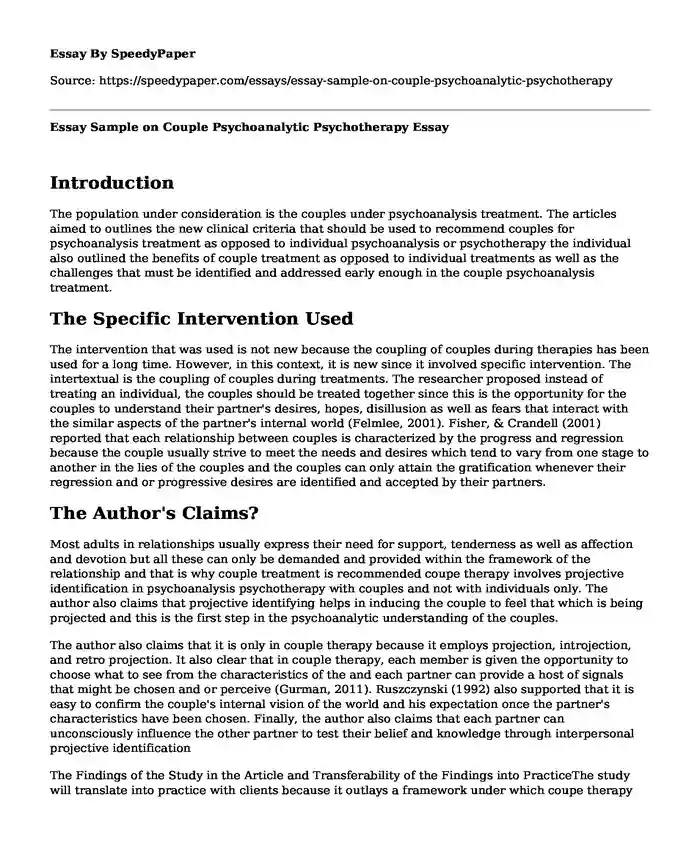
| Type of paper: | Course work |
| Categories: | Counseling Relationship |
| Pages: | 3 |
| Wordcount: | 775 words |
Introduction
The population under consideration is the couples under psychoanalysis treatment. The articles aimed to outlines the new clinical criteria that should be used to recommend couples for psychoanalysis treatment as opposed to individual psychoanalysis or psychotherapy the individual also outlined the benefits of couple treatment as opposed to individual treatments as well as the challenges that must be identified and addressed early enough in the couple psychoanalysis treatment.
The Specific Intervention Used
The intervention that was used is not new because the coupling of couples during therapies has been used for a long time. However, in this context, it is new since it involved specific intervention. The intertextual is the coupling of couples during treatments. The researcher proposed instead of treating an individual, the couples should be treated together since this is the opportunity for the couples to understand their partner's desires, hopes, disillusion as well as fears that interact with the similar aspects of the partner's internal world (Felmlee, 2001). Fisher, & Crandell (2001) reported that each relationship between couples is characterized by the progress and regression because the couple usually strive to meet the needs and desires which tend to vary from one stage to another in the lies of the couples and the couples can only attain the gratification whenever their regression and or progressive desires are identified and accepted by their partners.
The Author's Claims?
Most adults in relationships usually express their need for support, tenderness as well as affection and devotion but all these can only be demanded and provided within the framework of the relationship and that is why couple treatment is recommended coupe therapy involves projective identification in psychoanalysis psychotherapy with couples and not with individuals only. The author also claims that projective identifying helps in inducing the couple to feel that which is being projected and this is the first step in the psychoanalytic understanding of the couples.
The author also claims that it is only in couple therapy because it employs projection, introjection, and retro projection. It also clear that in couple therapy, each member is given the opportunity to choose what to see from the characteristics of the and each partner can provide a host of signals that might be chosen and or perceive (Gurman, 2011). Ruszczynski (1992) also supported that it is easy to confirm the couple's internal vision of the world and his expectation once the partner's characteristics have been chosen. Finally, the author also claims that each partner can unconsciously influence the other partner to test their belief and knowledge through interpersonal projective identification
The Findings of the Study in the Article and Transferability of the Findings into PracticeThe study will translate into practice with clients because it outlays a framework under which coupe therapy can be effective. The researcher also provides an adequate rationale for adopting specific approaches as well as the theoretical underpinning for couple therapy including countertransferential terms, the impacts of couple therapy on conflict resolution. The articles also found that through couple therapy the couple can attain the insight they need to understand their fundamental conflicts which are not popsicle in individual treatments (Aznar-Martinez, et al, 2016). The researcher also proves that it is only in couple therapy that the presence of the partners can help the therapists in alleviating suffering among the married people. The intersubjective dimension is, therefore, easier to put into perspective in couple therapy that individual treatment enabling them to understand and respond to partners needs
Possibility Go the Limitations of the Study Might Impacting My Ability to Use the Findings
The main limitation of the study is not clearly delineated but the limitation cannot impact my ability to use the findings in practices. This was a case study design but the study has high external validity. The fact that the researcher was base on a case study design only limits its transferability but their context in which it can be used especially among the white-collar couple having a dysfunctional relationship.
References
Aznar-Martinez, B., Perez-Testor, C., Davins, M., & Aramburu, I. (2016). Couple psychoanalytic psychotherapy as the treatment of choice: Indications, challenges, and benefits. Psychoanalytic Psychology, 33(1), 1-20. Doi:10.1037/a0038503
Gurman, A. S. (2011). Couple therapies. In S. B. Messer and A. S. Gurman (Eds.), Essential psychotherapies: Theory and practice (pp. 1-39). New York: Guilford Press.
Ruszczynski, S. (1992). Notes towards a psychoanalytic understanding of the couple relationship. Psychoanalytic Psychotherapy, 61, 33-48. Doi.Org/10.1080/02668739200700291
Felmlee, D. H. (2001). From appealing to appalling: Disenchantment with a romantic partner. Sociological Perspectives, 44, 263-280. Doi.org/10.2307/1389707
Fisher, J., & Crandell, L. (2001). Patterns of relating in the couple. In C. Clulow (Ed.), Adult attachment and couple psychotherapy: The 'secure base' in practice and research (pp. 15-27). New York: Brunner-Routledge
Cite this page
Essay Sample on Couple Psychoanalytic Psychotherapy. (2023, Jan 21). Retrieved from https://speedypaper.com/essays/essay-sample-on-couple-psychoanalytic-psychotherapy
Request Removal
If you are the original author of this essay and no longer wish to have it published on the SpeedyPaper website, please click below to request its removal:
- Essay on the Effects of Technology on Manual Jobs. Research Findings.
- The Expected Outcome of an Invent - Probability Theory Essay Sample
- Memento Film Essay Example
- Business Plan for the Family Entertainment Center, Free Paper Example
- Essay Sample Assessing the Effectiveness of News Website
- Free HRM Essay Evaluating the Hiring Decision
- Research Proposal Paper Sample on Business Mergers and Acquisitions
Popular categories




